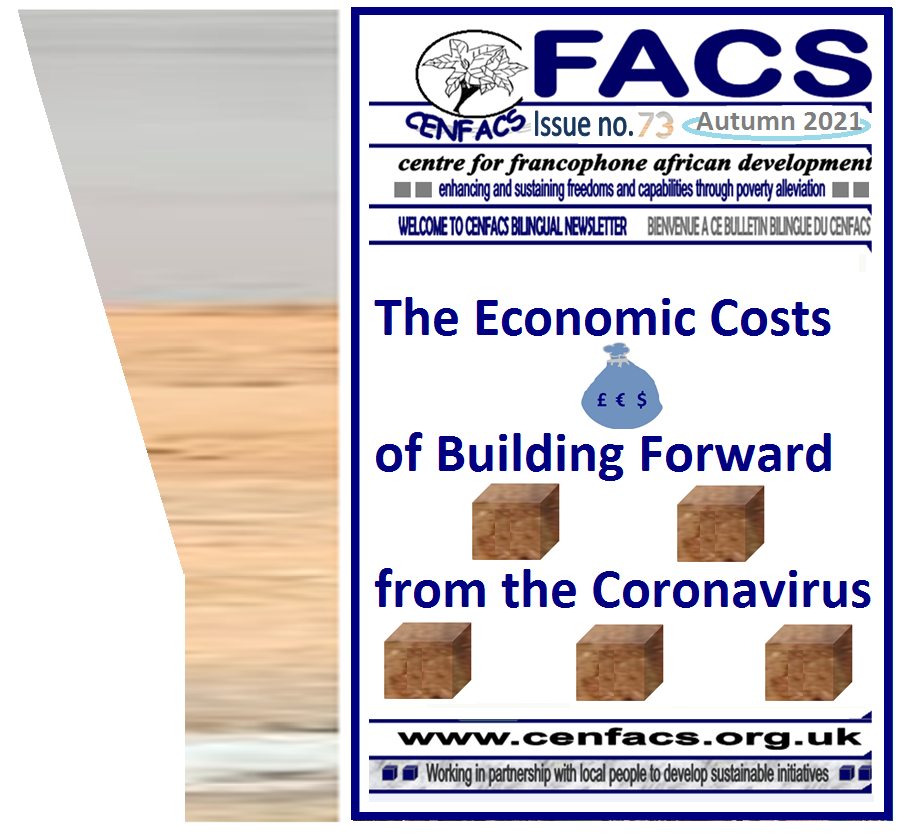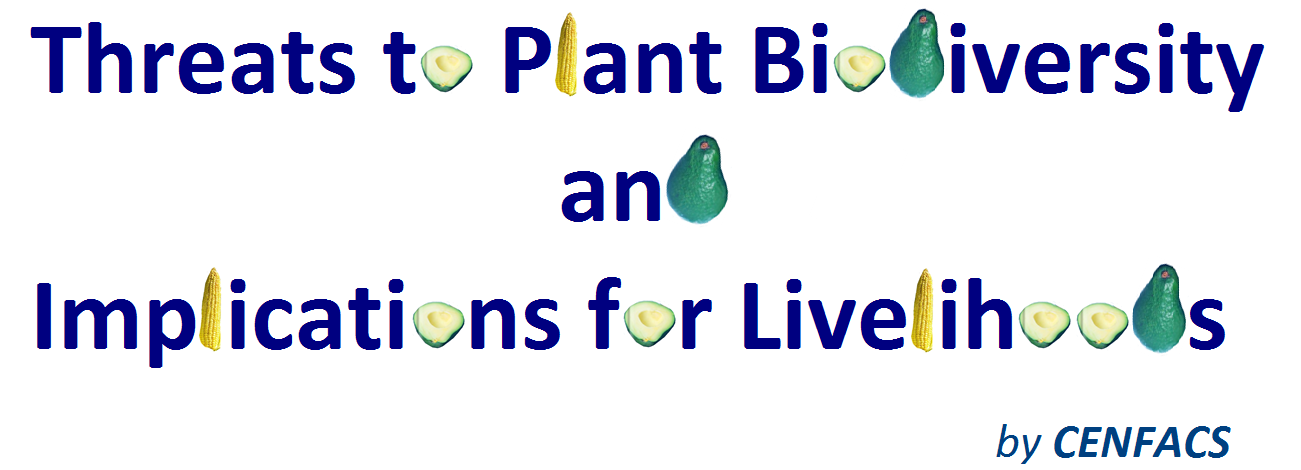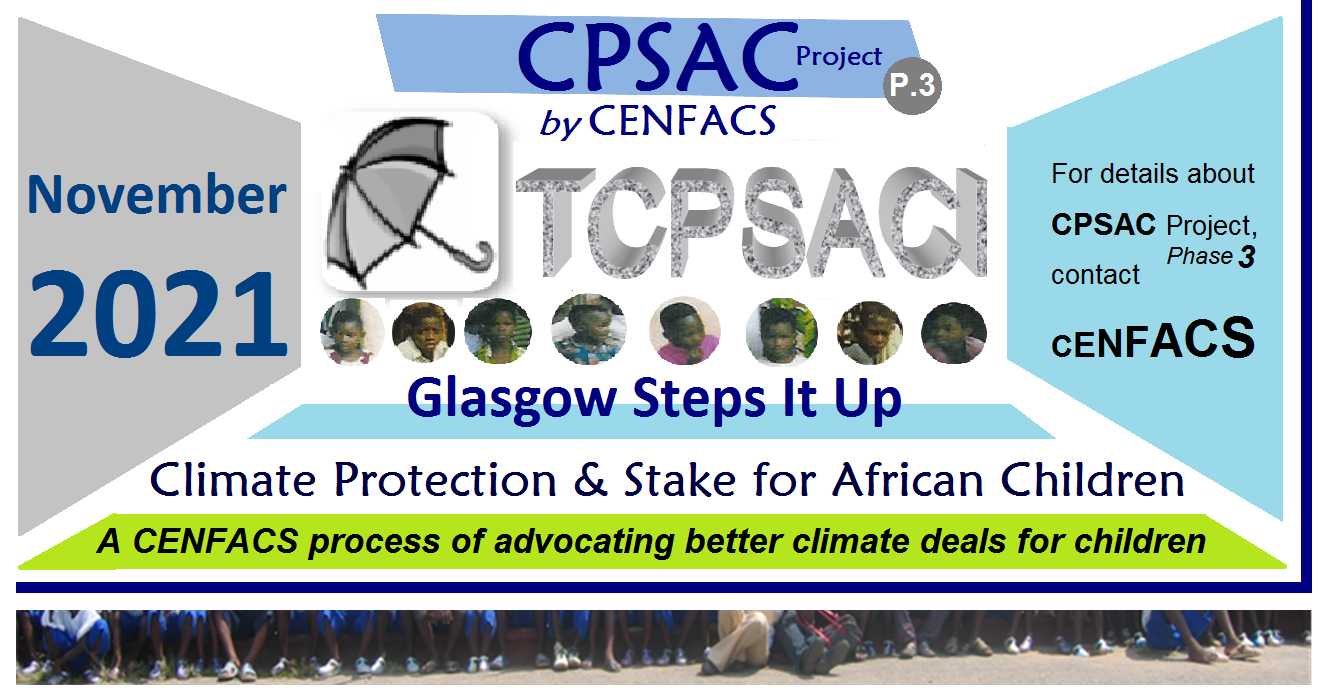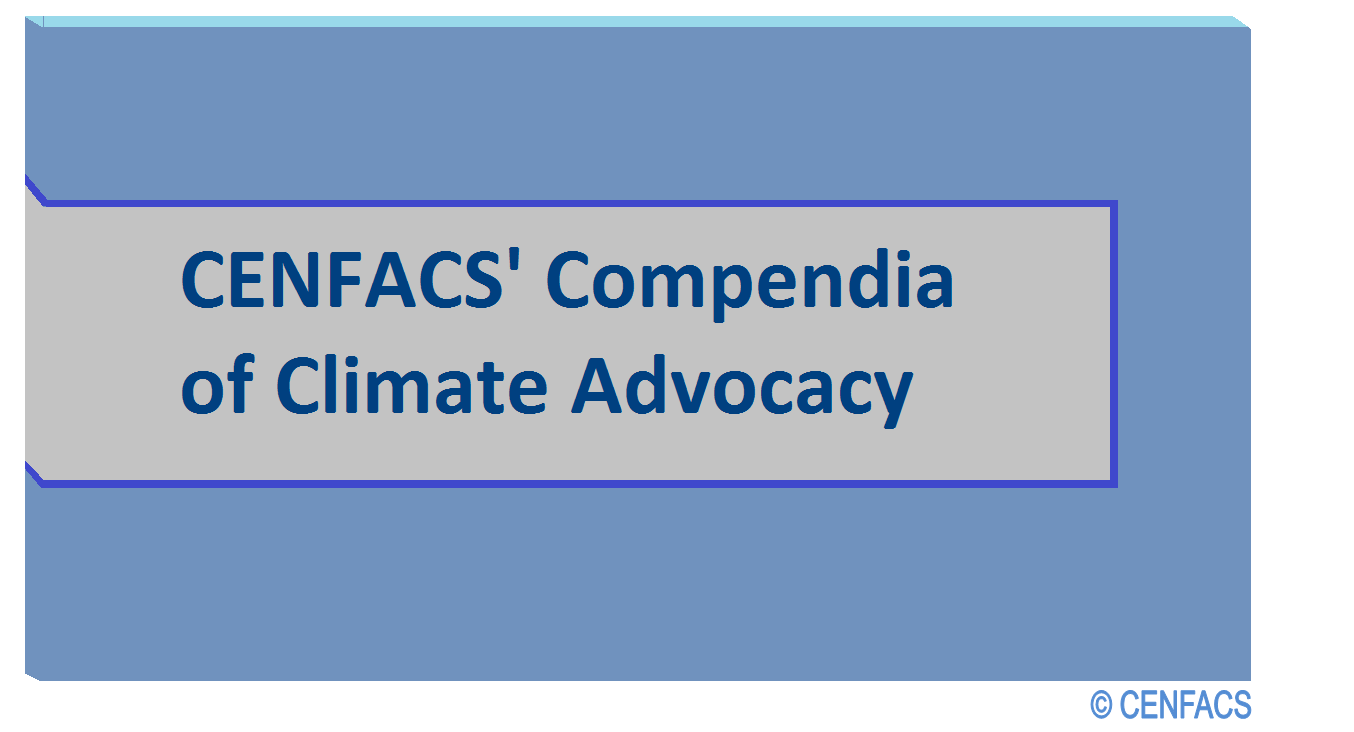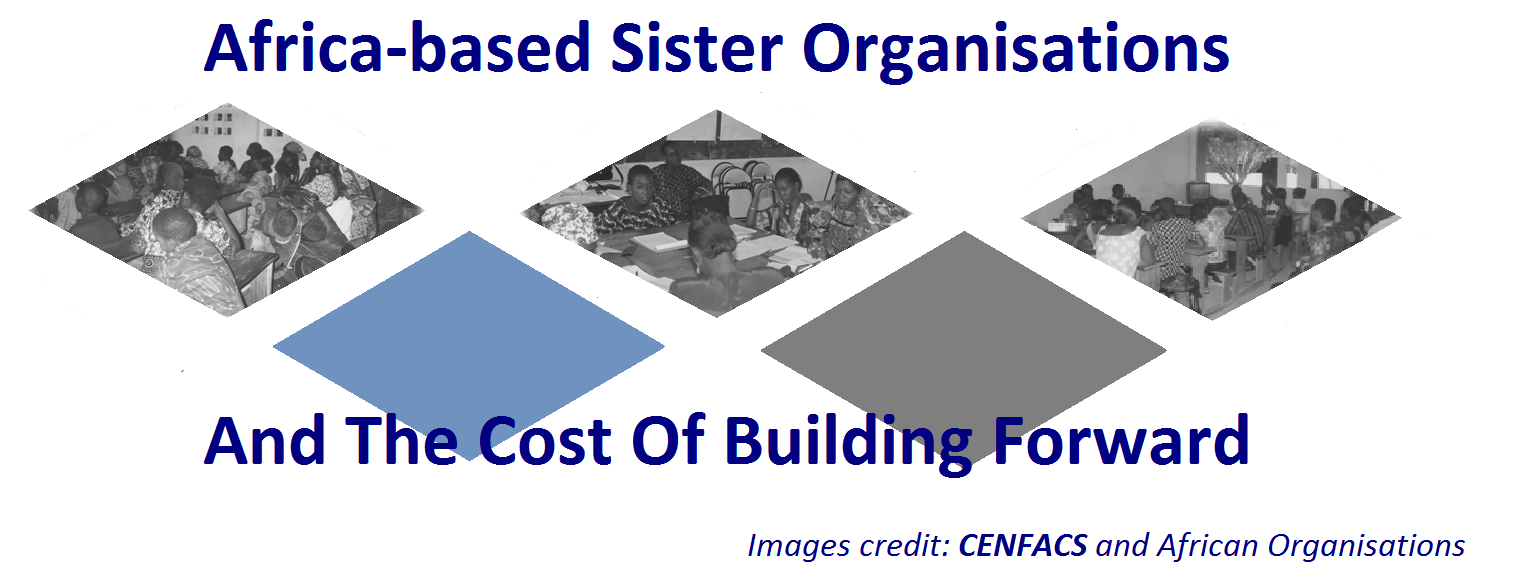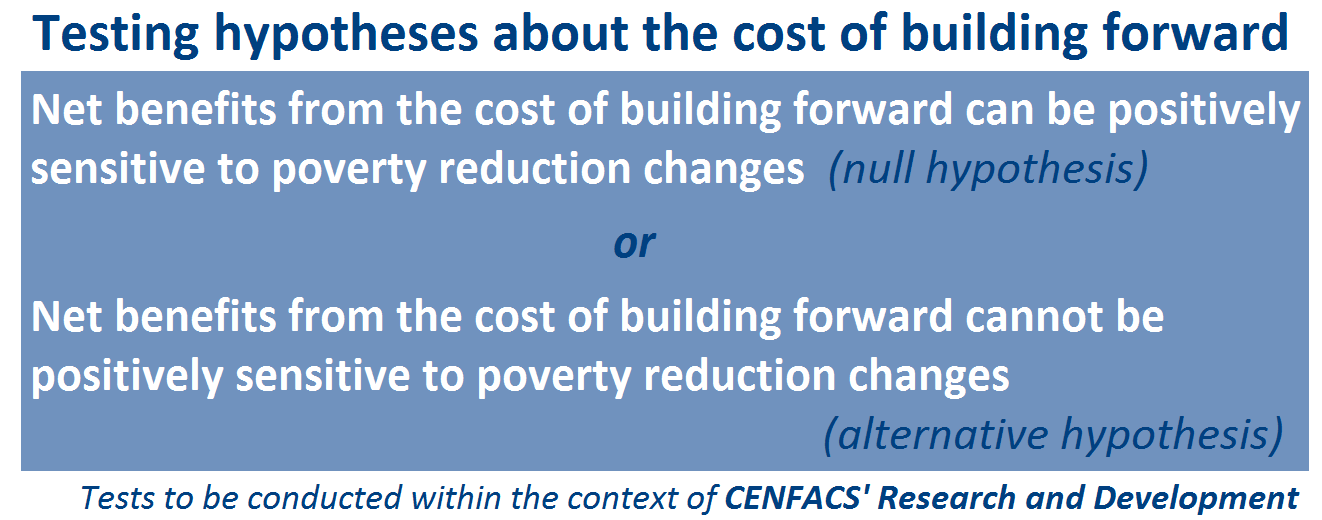Welcome to CENFACS’ Online Diary!
27 October 2021
Post No. 219
The Week’s Contents
• FACS, Issue No. 73, Autumn 2021: The Economic Costs of Building Forward from the Coronavirus
• 2021 “A la une” (Autumn Leaves of Action for the Upkeep of the Nature in Existence) Themed Activity and Action No.3 from Week Beginning 25/10/2021: Threats to Plant Biodiversity and Implications for Livelihoods
• Climate Protection and Stake for African Children – Phase 3: The Last 8 Campaigning Points (CENFACS’ Compendium 3 of Climate Advocacy)
… And much more!
Key Messages
• FACS, Issue No. 73, Autumn 2021: The Economic Costs of Building Forward from the Coronavirus
The 73rd Issue of FACS, CENFACS’ bilingual newsletter, focuses on the Economic Costs of Building Forward from the Coronavirus. It deals with economic costs rather than the other costs (such as human, health, environmental, social, etc.).
Although we know that it is difficult to separate economic costs from other ones, the focus in the 73rd Issue is economic; that is, on how to allocate scarce resources between competing uses in order to build forward from the damages caused by the coronavirus. Being able to do that will help to figure out the margin of manoeuvre one has in order to reduce poverty and enhance sustainable development.
This treatment of economic costs will cover costs relating to CENFACS, its Africa-based Sister Organisations and the community in the process of building forward. This process has already started since we launched CENFACS’ Build Forward Better Programme. The Issue will pick up those economic costs linked to this programme.
So, the key message here is that in order to build forward better from the painful legacies of the coronavirus one (be it CENFACS or Africa-based Sister Organisations or even project beneficiaries) needs to have a better control of the economic costs (or payments) to be incurred in this process.
Under the Main Development section of this post, we have provided the key summaries making this Issue.
• 2021 “A la une” (Autumn Leaves of Action for the Upkeep of the Nature in Existence) Themed Activity and Action No.3 from Week Beginning 25/10/2021: Threats to Plant Biodiversity and Implications for Livelihoods
We would like to start this 3rd themed activity or action to Safeguard Crop Wild Relatives with what Richard T. Corlett (1) said; which is:
“The conservation of plants has not generated the sense of urgency – or the funding – that drives the conservation of animals, although plants are far more important for us”.
Perhaps, it is now time for anyone to understand the above say and mostly take action by giving the sense of urgency and funding that plants need and deserve in order to Safeguard Crop Wild Relatives threatened by extinctions.
• • Threats to plant biodiversity
Plants are still at risk of both in situ and ex situ extinctions. According to Corlett (op. cit.), the major threats to plant biodiversity (that is, the number of genetic strains or differences within plant species) include: habitat loss, fragmentation and degradation, over-exploitation, invasive species, pollution and anthropogenic climate change.
In order to achieve the goal of zero global plant extinctions and Safeguard Crop Wild Relatives, actions need to be taken. These actions could include the following:
√ Develop the sense of urgency for threatened plants
√ End extinctions of not recorded plant species
√ Protect the natural ecosystems that plants play or act for as well as services plants provide
√ Take urgent actions to save threatened plants
√ Fund projects relating to the Safeguard of Crop Wild Relatives
√ Stop habitat loss, fragmentation, degradation,
√ Reduce or control over-exploitation
√ Prevent invasive species to destroy plants
√ Stop air pollution to plants
√ Reverse the adverse effects of anthropogenic climate change
√ Conserve the botanical inventories and improve plant inventory
√ Often reassess the conservation status of plant species
The above actions are important to reduce and possibly stop threats to plant biodiversity, threats which have some implications for livelihoods.
• • Implications for livelihoods
Threats to plant biodiversity have some consequences for the way in which humans and animals live their lives. They also impact the health and wealth of plants. These threats have some connotations as well for the poor and vulnerable people in their capabilities, assets and activities they require for a meaningful life now and in the future. If these threats continue, this could mean worsening of the quality of life for all the three beings (humans, animals and plants). That is why one needs to take the above mentioned decisive actions.
To support and campaign with us to reduce and or stop threats to plant biodiversity, please contact CENFACS.
• Climate Protection and Stake for African Children – Phase 3: The Last 8 Campaigning Points (CENFACS’ Compendium 3 of Climate Advocacy)
Our process of advocating better climate deals for children, particularly but not exclusively African children, in the context of global climate talks continues this week with the last eight Campaigning Points of CENFACS’ Compendia of Climate Advocacy (2).
• • Compendium 3: The last 8 Climate Campaigning Points on the Way to COP26
The eight points we are dealing with this week in the lead up to the COP26 include the following:
(21) The political economy of negotiations for child protection against climate-induced poverty
(22) Green and climate capacity building and education for child protection
(23) Climate-friendly and children-friendly technologies for poverty relief
(24) Climate change adaptation and mitigation programmes for children and future generations
(25) Making clean technology fund (CTF) work for poor children from poor nations
(26) The equity resulting from converted CTF debt to benefit children from poor nations as well
(27) The new pledges, if any, for adaptation fund and Least Developed Countries Fund to be mobilised to give a stake to poor children’s needs
(28) Mobilisation of the climate finance system and architecture to be designed so as to support poor children of poor countries
Our work regarding the above mentioned campaigning points in the run up to the COP26 is to find ways of making sure that these points could be included in the deliberations that will take place in Glasgow without stealing the purpose and process of the global climate talks. It is also about having some insurance that the outcomes to be reached in Glasgow will positively reflect the points made above. One can hope that Glasgow could step it up and make it for children and the generations to come.
To support CPSAC-P.3 and the sub-theme of ‘Glasgow Steps It Up’ as well as any of the 28 Climate Campaigning Points of CENFACS’ Compendia of Climate Advocacy, please contact CENFACS.
Extra Messages
• Happening this Week: Making Memorable Difference Project
In Focus: The Congolese Rumba
The 13th Event of Making Memorable Difference Project is in progress as scheduled. It is the celebration of African Abilities, Talents, Skills, Legacies and Gifts to Africa and the world.
For those who would like to make contribution to our Virtual Two Days of African History, they are welcome to do so. They can contribute to the understanding of the Congolese Rumba as Culture, Art and Patrimony; and or to its Legacies and Gifts in terms of poverty reduction and sustainable development.
• • How to engage and or contribute
You can tell and share with us what they know about the Congolese Rumba as Culture, Art, Patrimony, Legacy and Gift. Your telling or sharing could be in the form of:
texts, documents, references, relics, audio and visual materials, art objects and any other historical resources.
For those who can, they could support CENFACS’ Two History Days and Making Memorable Difference Project with a donation to acknowledge our efforts, to help us recover costs of organising such eventful days and to build forward better African History.
To engage with this year’s Making Memorable Difference theme and or support this project, please contact CENFACS on this site.
• Poverty Reduction Goals Project – Goals No. 2 and 3: Simultaneous Reduction of Consumption Poverty and Energy Poverty
Last month when we dealt with the reduction of energy poverty, we argued that the seven goals making CENFACS’ 2020s Poverty Reduction Programme and Development Agenda (3) do not have to be treated and implemented separately. Any of these goals should not be studied and implemented in isolation. There are and could be relationships between them.
To highlight what we have just said we are revisiting Poverty Reduction Goal 2 and Poverty Reduction Goal 3; that is Reduction of Consumption Poverty and Reduction of Energy Poverty respectively. The current work on these goals is about what is happening now with the increases of energy price and of consumer demand.
• • The current state of consumption poverty and energy poverty
With the current increases in the prices of gas and electricity, electronics, wood and plastic; there could be increase in both consumption poverty and energy poverty.
The consumption poverty could increase because there is a shortage of the supply of commodities (food stuff) and goods to meet high level of post-COVID-19 awakening demand. Obviously, when the supply of commodities and food stuff is lower than their demand, the most sufferers are those who are already poor or the consumption poor.
The same is happening with the rise of energy price which is likely to increase energy poverty. In these circumstances, what can one do to help simultaneously reduce consumption poverty and energy poverty, which already exist?
• • Helping to simultaneously reduce consumption poverty and energy poverty
Our work is to continue to campaign so that every effort could be deployed to help simultaneously reduce consumption poverty and energy poverty within the community we serve, at this moment of commodities and food stuff shortages, strong demand of raw materials and soaring prices of energy.
We are as well asking purchasing managers of poverty reduction goods to share with us their experience in dealing with the supply and stock of these goods in order to help meet poverty reduction goals, particularly the reduction of consumption poverty.
If you are a purchasing manager for the poverty reduction goods, CENFACS would be interested in hearing your experience/story on how you are supporting the community to overcome consumption poverty at this time.
Likewise, we are asking the community itself to share their experience about the sensitivity of the energy share to their household income.
To share your experience and knowledge, please contact CENFACS.
• Activity of the Week: Leaving behind the Monetary Threshold of US $1.90 a Day
Is it a sign of building forward from the COVID-19 damages?
This week, we are also building on the activity about the line of extreme poverty like we did in October 2020. We are doing it since the adverse effects of coronavirus pandemic and subsequent lockdowns in terms of extreme poverty are still lingering within the community. Now, we have as well the negative effects of increased energy price on the extremely poor.
However, in all this picture there could be some positive stories from those who have managed to leave behind them the international poverty line of $1.90 a day. For those ones, leaving it behind could be regarded for some as a sign of starting to build forward from the painful legacies of COVID-19 and its ramifications, whereas for others it is not the case.
If you did leave the monetary threshold of US $1.90 a day behind and being in the direction of going out of extreme poverty, we would like to hear your experience/story.
To share your experience/story of leaving the international poverty line behind, please contact CENFACS.
Le 73e numéro de FACS vient de paraître. Ceux ou celles qui sont intéressés à lire ce nouveau numéro en détail peuvent contacter le CENFACS à notre adresse habituelle sur ce site internet.
Main Development
• FACS, Issue No. 73, Autumn 2021: The Economic Costs of Building Forward from the Coronavirus
The contents and key summaries of the 73rd Issue of FACS are given below.
• • Contents and Pages
∝ Accounting for the cost of building forward from COVID-19 (Page 2)
∝ Basic financial planning and forecasting in the process of building forward (Page 2)
∝ The price of curating damaged and destroyed activities (Page 3)
∝ The cost of building forward that considers net zero emissions by 2050 (Page 3)
∝ The cost of building forward that takes into account nature-based solutions (Page 4)
∝ Africa-based Sister Organisations and the cost of building forward from the coronavirus (Page 4)
∝ Que sait-on du coût de reconstruction à partir du COVID-19 pour des organisations africaines? (Page 5)
∝ Combler l’asymétrie dans l’effort ou le coût de construction vers l’avant: Ce que le COVID-19 a entraîné pour les pauvres (Page 5)
∝ Le coût associé à l’inactivité économique non-essentielle découlant des confinements prolongés des usagers de CENFACS (Page 6)
∝ Le coût d’une reconstruction meilleure ensemble plus verte et plus propre (Page 6)
∝ The cost of eradicating vaccine inequity and inequality (Page 7)
∝ The cost of building forward that attracts financial innovations (Page 7)
∝ The cost of building forward that responds to the economic absorption capacity (Page 8)
∝ The cost of building forward that is smart (Page 8)
∝ Community research and development about economic costs to build forward (Page 9)
∝ Survey about the cost of building forward (Page 9)
∝ E-focus group discussions on the cost of building forward (Page 9)
∝ Cost Centre Project (Page 10)
• • Key Summaries
Please find below the key summaries of the 73rd Issue of FACS from page 2 to page 10.
Accounting for the cost of building forward from COVID-19 (Page 2)
In order to build forward from the economic and health crisis created by the coronavirus pandemic, one needs to do accounting for COVID-19 accounts or the share of COVID-19 accounts in their households or African organisational accounts. This could mean the given household or African organisation will record the transactions or amounts of cost linked to COVID-19 payments and other costs. This will enable to have an accounting picture or photo for the spending relating to COVID-19 and other accounts.
In practical terms, most of households and persons making our community should be able to do basic accounting to record how much they spend. Africa-based Sister Organisations (ASOs) can do the same.
Briefly, accounting for the cost of payments made could be a starting point in the process of working out the economic costs of building forward from the damaging legacies of COVID-19.
Basic cost planning and forecasting in the process of building forward (Page 2)
The accounting for the cost of building forward from COVID-19 does only give us the history of our accounts or where we are coming from. But, it does not tell us where we want to go. To build forward, one needs to go beyond the state of costs incurred. In other words, one (household or ASO) has to financially plan and/or forecast costs or payments.
Financial planning deals with preparations or arrangements for finances while forecasting is about making predictions about future general economic and market conditions. Because we are concerned with costs, one can make cost planning and forecasting.
In practical terms, it means that the given household or ASO needs to estimate costs and develop hypotheses regarding the evolution of some key indicators or variables (such as inflation, interest rate, exchange rate, etc.).
For example, CENFACS household users can ask themselves if the price of gas goes up, how this increase will affect their household energy budget or cost and the rest of the bills they pay. By doing so, these households can integrate the responses to these questions in their decision making process on costs and write their cost plan and forecast to build forward from the COVID-19.
Those households who handle financial statements (such as cash flow projections, balance sheets, profit and loss accounts for their family) may be familiar with the above. For those who are unfamiliar with them, they can always ask CENFACS for any help on the matter.
The price of curating damaged and destroyed activities (Page 3)
There is always a price to be paid or a cost to bear when curating activities and or services as a result of damages or destruction caused a major crisis like the coronavirus pandemic. Our users and ASOs may find themselves that they need first to cost activities or things to be cured before moving onto the phase of building forward or while they are in this phase.
If they are able to do it they can do it themselves. Alternatively, they can use available tools on the market such as cost calculator. They can as well ask support to CENFACS to help them determine the price or cost of curating what they were doing and which the COVID-19 has destroyed or damaged.
To ask for support about working out the price or cost of curating your activities, please do not hesitate to contact CENFACS.
The cost of building forward that considers net zero emissions by 2050 (Page 3)
It is possible to work out the cost of building forward in such way that does not add to the amount of greenhouse gases in the atmosphere. It means when considering the different payments, one may need to budget and record any costs linked to CO2 emissions they would emit. This includes greenhouse gas emissions from their households.
For example, if one wants to cost the price of kitchen appliances they may need in order to build forward, they could consider non-polluting appliances for cooking as well as any carbon-free installation they need.
In short, when accounting the cost of building forward one may think of considering the cost of taking green and clean paths.
The cost of building forward that takes into account nature-based solutions (Page 4)
The construction for the cost of building forward can include nature-based solutions to poverty. Such costs need to consider actions to protect, sustainably manage and restore natural and modified ecosystems.
These costs will as well include solutions to poverty that enhance the wealth and health of nature. For example, planting trees, restoring biodiversity of plants and animals and other nature-based solutions can be factorised in the cost of building forward so that when searching for ways of reducing and or ending poverty people can make choices that conserve and protect the nature.
In all, the cost of building forward can be worked out in such way as to bring in nature-based solutions.
Africa-based Sister Organisations and the cost of building forward from the coronavirus (Page 4)
COVID-19 has affected the way in which ASOs deliver their programmes, projects, activities and services. It has affected them from within and outside. COVID-19 is an adjusting factor for them as it has impacted the ability to raise funds and to continue to help in reducing poverty and hardships amongst their users.
In these circumstances, the cost of building forward for them may include in their cash flows the cost of adjusting their way of finding their finances in order to meet the needs of their users and community. This is because searching for and finding finances are not always free for many of these organisations.
In brief, if ASOs need to raise up to the challenge of delivering post-COVID -19 poverty reduction services that lift more of their people out of poverty and hardships, they have to be prepared to properly cost their sources of finance in order to build forward.
Que sait-on du coût de reconstruction à partir du COVID-19 pour des organisations africaines? (Page 5)
Les organisations africaines avec lesquelles le CENFACS travaille sont dans des situations différentes qui sont les suivantes:
∗ Il y a des organisations qui continuent de faire face aux coûts sanitaires et financiers de combat contre le COVID-19 là où le COVID-19 continues de grimper parmi leurs adhérents
∗ Il y en a d’autres qui ont commencé d’élaborer le coût de guérison de leurs activités, car elles ont entamé le travail de guérison de leurs systèmes et services de réduction de la pauvreté endommagés
∗ Il y a une troisième catégorie d’organisations qui ont débuté le travail de reconstruction proprement dit.
Selon les differences dans les phases de reconstruction, les coûts varieront et l’approche de reconstruction peut aussi être différente. Par exemple, pour celles qui continuent de lutter contre le COVID-19, les coûts sanitaires et hygiéniques seront présents et élevés, tandis que pour celles qui entreprennent le travail de guérison, elles seront plus concernées par des coûts de réparation. Enfin, pour celles qui ont, à juste titre, commencé le travail de réhabilitation, les coûts relatifs à la reconstruction seront dominants.
En gros, le coût de reconstruction pour des organisations dépendra de la situation dans laquelle elles se situent.
Combler l’asymétrie dans l’effort ou le coût de construction vers l’avant: Ce que le COVID-19 a entraîné pour les pauvres (Page 5)
Pendant la période du COVID-19, on a assisté à une répartition asymétrique et disproportionnelle des moyens et ressources sous forme d’aide au combat contre le COVID-19 dans une partie du monde. Certaines couches sociales ont reçu plus d’aide par rapport aux autres. D’autres couches se sont vues mêmes abandonnées pour elles-mêmes.
Pour aider à combler cette asymétrie ou disproportion, il serait mieux que des organisations africaines continuent à réhausser le ton et travailler avec leurs usagers qui ont été victimes de cette répartition inégale des moyens; répartition qui peut influencer l’effort ou le coût de construction vers l’avant. En travaillant avec ces sections ou couches défavorisées ou les laissé(e)s-pour-contre de la répartition des moyens de combat contre le COVID-19, il y aura une lueur d’espoir pour faire disparaître les disparités crées.
Pour conclure, il y a lieu de noter qu’il serait mieux de corriger l’asymétrie du coût de construction vers l’avant pour que les pauvres voient leur situation s’améliorer.
Le coût associé à l’inactivité économique non-essentielle découlant des confinements prolongés des usagers de CENFACS (Page 6)
Il y a des coûts à comptabiliser pour nos usagers et leurs membres de famille oeuvrant dans le secteur non-essentiel et qui ont été incapables de travailler à cause de COVID-19 et ses ramifications.
Ces coûts incluent des dépenses de développement des compétences, de formation et d’éradication de la pauvreté. A cause de la longueur des confinements, certains de nos usagers ont vu certaines de leurs compétences réduites ou perdues. Pour construire vers l’avant les compétences réduites et perdues, cela demande de stages de formation et d’éducation pour leur permettre de rejoindre le marché de travail. Pour ceux ou celles qui ont acquis des compétences nouvelles relatives au travail à distance ou distanciel, il y a aussi des coûts à calculer pour qu’ils (elles) continuent d’avancer.
Brièvement parlant, des économiquement inactifs à cause des confinements et de manque d’activité économique ont des coûts à comptabiliser que ça soient pour des compétences à acquérir ou celles déjà acquises.
Le coût d’une construction meilleure ensemble plus verte et plus propre (Page 6)
Pour construire vers l’avant, il faut tenir compte des exigences liées à la conservation de la nature et de l’évitement du dérèglement climatique. Pour cela, il y a lieu de d’adopter un chemin vert et propre.
Par exemple, de plus en plus des voies s’élèvent contre l’usage des ressources non-renouvelables ou combustibles fossiles (tels que le pétrole, le gaz et le charbon).
Cela demande une transition vers des énergies ou ressources renouvelables (telles que l’eau fraîche, la forêt, etc.). Pour assumer cette transition énergétique, cela demande un calcul des coûts de la transition et celui pour assurer une construction vers l’avant verte et propre.
Grosso modo, le coût de la cause verte et propre peut être intégrée dans la reconstruction à partir du COVID-19.
The cost of eradicating vaccine inequity and inequality (Page 7)
In the process of working out the monetary value of building forward, the cost of local people accessing vaccine needs to be taken into account. Particularly, for those who live in remote areas who may not always have the means to travel to access vaccine.
Therefore, working out the costs of travelling to reach out to them, of running vaccine administration hubs is important. It is important if one wants to eradicate vaccine inequity and inequality.
In a few words, the full cost of eradicating vaccine inequality and inequality has to be taken on board.
The cost of building forward that attracts financial innovations (Page 7)
To build forward, it requires funding. Since everybody, especially those in need, is looking for funding to deal with the unprecedented costs of COVID-19 crisis, traditional funding schemes have become oversubscribed and in some cases obsolete. Therefore, innovations in new financial instruments and sources of funding to cover the cost of building forward become unavoidable.
However, to attract these new innovations to one’s building forward projects and or programmes, the cost of these projects and programmes have to be attractive to them. In the process of setting up costs to build forward, it is advisable to undertake an intelligent combination of the ability to attract these new financial innovations and the capability to meet the needs of potential users.
In short, the design of cost to build forward needs to take into account the financial instruments on the market if one wants to access them.
The cost of building forward that responds to the economic absorption capacity (Page 8)
Any organisation whether it is small or medium or even big needs to have the absorption capacity required for any amount of investment received or to be received. They may need it to be able to smoothly absorb or channel the incoming build forward funds into their systems. It is not enough for organisations to say for example “this is our cost or this is how it costs”. So, having in mind an idea of absorption capacity or absorptive plan of any funds needed when costing your plan to build forward will help.
In concrete terms, let say an organisation costs its work of building forward at £50,000. The question is: do they have the infrastructures, structures, capacities, skills and knowledge to efficiently consume this seize of money to build forward? If not, wouldn’t be better for that organisation to re-work the costs and perhaps cut or increase them depending on their absorption capacity?
Briefly, it will make easier for the organisation to cost their work on building forward without ignoring their absorption capacity of any potential funds or investments to acquire.
The cost of building forward that is smart (Page 8)
The cost of building forward needs to be smart; that is specific, measurable, achievable, realistic and time-bound. It is a cost based on needs assessment of the individual or organisation; cost that does not to be general but that can be measured, achieved, realistic and for a defined time.
The above features about the cost of building forward are relevant for project users and organisations. For users or project beneficiaries, smart cost will be approached in the context of working with them so that they can navigate their way out of poverty. For ASOs, smart cost will be about the way in which they perceive it and apply it. However, whichever way they take it, the fundamentals of smart method of dealing with their problem of building forward will remain the same.
To sum up, keeping the cost of building forward smart can help to better deliver the objective of poverty reduction for both users and beneficiary organisations.
Community research and development about economic costs to build forward (Page 9)
CENFACS has two research projects about economic costs to which people can participate, which are the following:
a) Economic modelling and evaluation of economic costs
b) Testing the sensitivity of net benefits to poverty reduction changes.
a) Economic modelling and evaluation of economic costs
This is a project through which participants can develop a simple economic model and carry out economic evaluation on the economic costs of building forward as well as about generating some evidence that can be utilised to support the process of building forward better. The model could be a basic visual, mathematical, simulation, empirical, static, dynamic, etc.
b) Testing the sensitivity of net benefits to poverty reduction changes
To build forward and keep the work of poverty reduction on track at the same time could be challenging. To enable us to know in the setting of economic costs that poverty reduction changes will be preserved during the process of building forward, one can undertake some community research in testing the sensitivity of net benefits of the cost of building forward to poverty reduction changes.
To participate to either of the research projects, please contact CENFACS.
Survey about the cost of building forward (Page 9)
Please rate your experience of the cost of building forward
E-focus group discussions on the cost of building forward (Page 9)
As part of getting people’s activities and lives back on track and move forward during November 2021, we would like to e-discuss with those who are interested in the economic cost of building forward. This is because we all are likely to cost our build-forward projects from the damages caused by the coronavirus.
The e-discussion will be on the following:
1) How to recoup all the economic costs of building forward
2) Is it the cost of building forward bigger or smaller or average than what one would expect?
3) How to cover the cost of building forward
Those who would like to participate they can contact CENFACS so that we can plan this e-discussion session.
Cost Centre Project (Page 10)
This is a project designed to work with Africa-based Sister Organisations in order to help them alleviate poverty due to the lack of systematic and analytic method and system to set up and collect costs needed to build forward.
Through this project, these organisations will better plan, organise, coordinate, control and monitor their cost of building forward from the economic and health impacts of the coronavirus pandemic at a cost centre. The setting up of costs via this project will be aligned with poverty reduction budgets and goals of those organisations.
To support or contribute to this project, please contact CENFACS.
For further details including full project proposals and budget about the Cost Centre Project for Africa-based Sister Organisations, please contact CENFACS.
The full copy of the 73rd Issue of FACS is available on request. For any queries and comments about this Issue, please do not hesitate to contact CENFACS.
_________
References
(1) Richard T. Corlett (2016), Plant diversity in a changing world: Status, trends and conservation needs at https://doi.org/10.1016/j.pdf.2016.01.001 (accessed October 2021)
(2) CENFACS (2019), CENFACS’ Compendia of Climate Advocacy at Festive Guide – (cenfacs.org.uk)
(3) CENFACS (2020), CENFACS’ 2020s Poverty Reduction Programme and Development Agenda at The 2020s Development Agenda and Poverty Reduction Programme – (cenfacs.org.uk)
_________
Help CENFACS keep the Poverty Relief work going this year.
We do our work on a very small budget and on a voluntary basis. Making a donation will show us you value our work and support CENFACS’ work, which is currently offered as a free service.
One could consider a recurring donation to CENFACS in the future.
Donate to support CENFACS!
FOR ONLY £1, YOU CAN SUPPORT CENFACS AND CENFACS’ PROJECTS, JUST GO TO :Support Causes – (cenfacs.org.uk)
Thank you for visiting CENFACS website and reading this post.
Thank you as well to those who made or make comments about our weekly posts.
We look forward to receiving your regular visits and continuing support throughout 2021 and beyond.
With many thanks.
